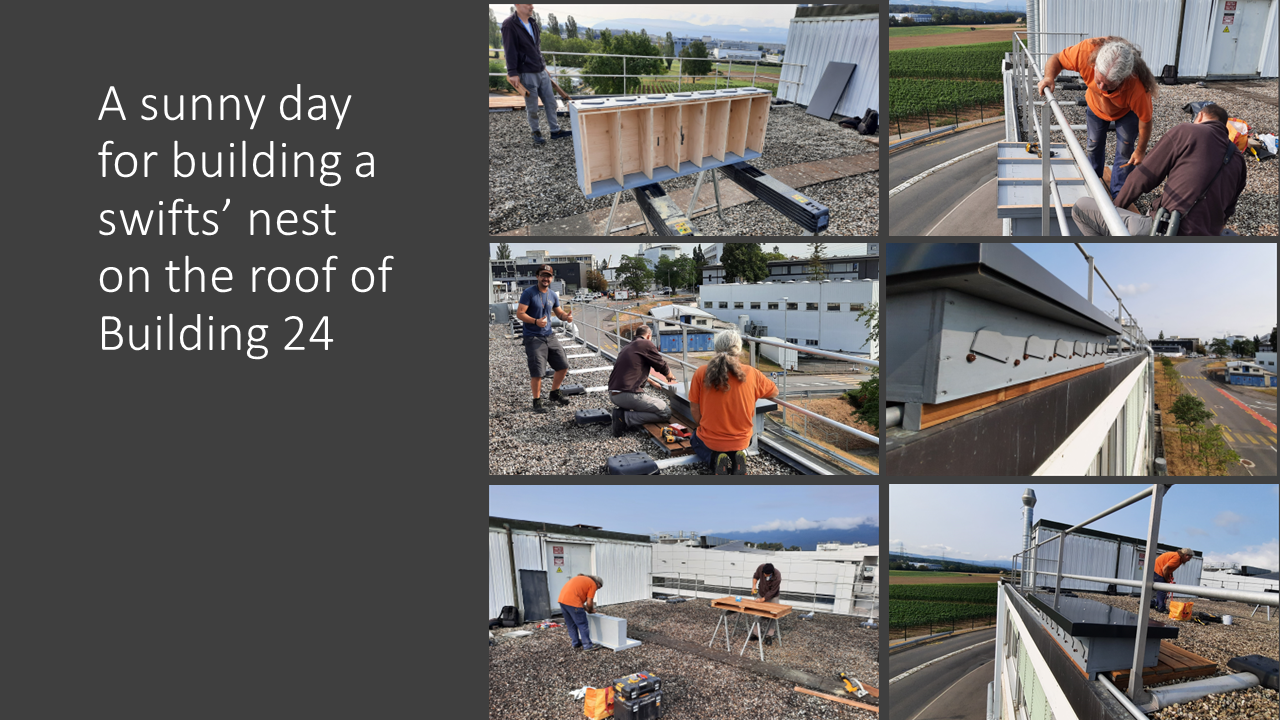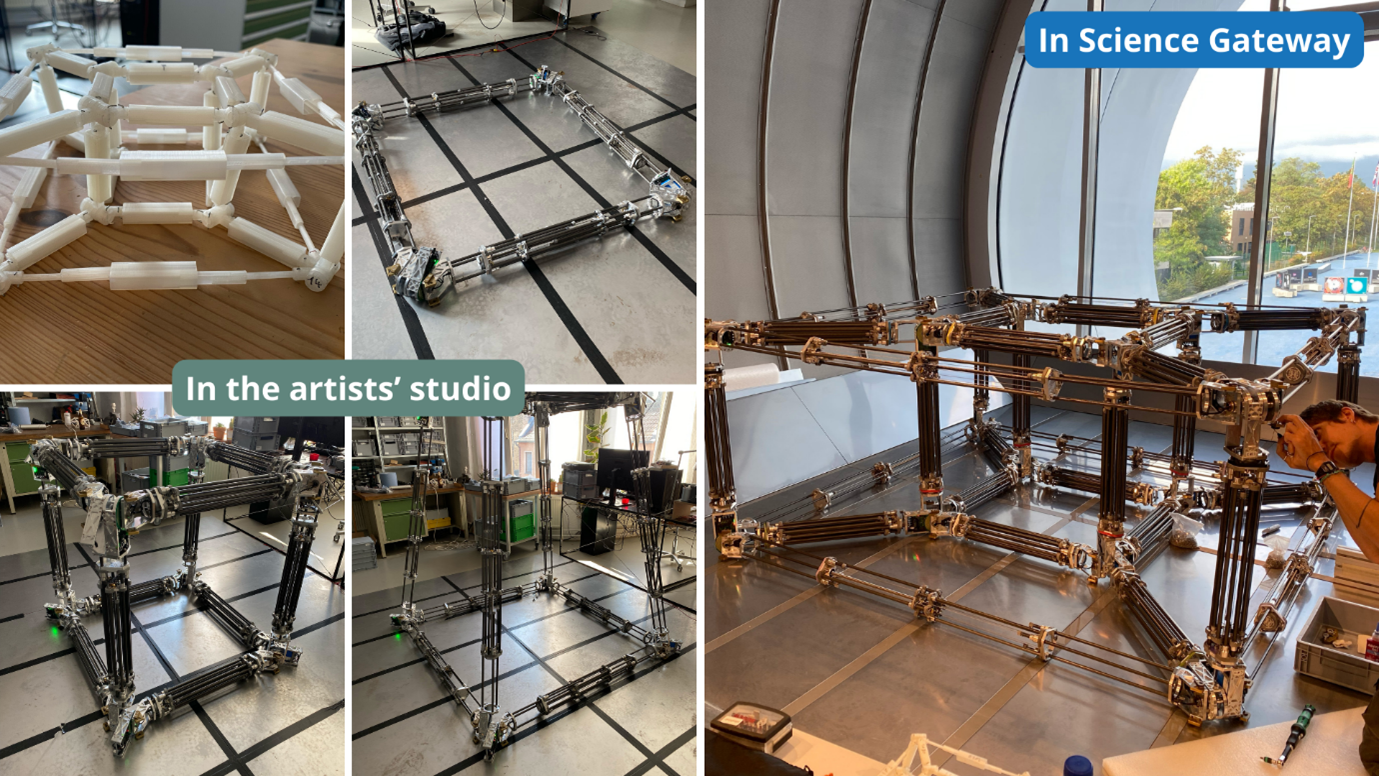
December 2023
Welcome to the HSE Newsletter, the fourth in a series to be published at least twice a year and featuring some selected highlights for the HSE Unit. You can find the other editions here or in the side menu.
We thank the contributors and encourage anyone who has a newsworthy story to share it with us at hse-comms@cern.ch. We will then publish it on the most appropriate channel, including the CERN Bulletin or the HSE website.
A PDF-version of this newsletter is available on EDMS.
Happy reading!
Contents
Giving a home to swifts
On 30 of August, some unusual activity took place on the roof of building 24. Jean-Paul Bergoeing, environmental engineer in the HSE-ENV Group, who was installing swift nests that day, tells us more.
Click here to read more
– Jean-Paul, can you give us some background on swifts at CERN and why action was needed?
It's important to highlight for context that our activities at CERN often intersect with various species more frequently than we might realise, and this interaction has the potential to endanger these species. For instance, swifts (‘martinets’ in French), which are strongly protected by both Swiss and French regulations, frequently use our facilities as nesting sites. Particularly in densely built areas these birds find refuge in the small spaces between the blinds of office windows (you might even spot some right outside your window !!). This exposes them to considerable risks, such as the potential destruction of their nests or harm to their chicks when we open or close the blinds.
30 August saw the culmination of a project to address this: we constructed temporary nesting facilities on the roof of Building 24 to provide a safe haven for them. This action is in line with CERN's commitment to promote biodiversity on its premises. The initiative is expected to benefit as many as 8 swift couples, allowing them to securely complete their reproductive cycle.
– Why is it important to install nests for swifts?
Protecting the swifts and, in turn, contributing to the goal of safeguarding the biodiversity of our Organization forms part of our efforts to minimize CERN's impact on our environment and promote the natural balance of our ecosystem. Alexander von Humboldt’s (1769 – 1858) postulate that nature is intricately interconnected is still valid, if often overlooked.
Swifts exhibit very different behaviours compared to other birds commonly seen in cities. They spend a significant portion of their lives in the air, unlike pigeons or sparrows that are often found on the ground. Swifts can stay in flight for up to 10 months without pause, eating, mating, and even sleeping by switching off half of their brain. At an altitude of 3000 meters, a short nap over Lake Geneva can take them as far as southern Spain before they wake up and begin their journey back.
Adaptation to this aerial lifestyle has led them to develop extremely short legs. In fact, if they land on the ground, they have great difficulty taking off again. Here's a little tip: if you happen to come across a stranded swift, consider approaching it with care, gently pick it up, and lift it to help it take flight again!
As for their nesting habits, swifts prefer to nest in high and exposed locations. This choice enables them to take off effortlessly, granting them convenient access to find food for their chicks. If civilization didn't exist in Geneva, swifts would likely build their nests on the rocky cliffs of Salève or in the Jura mountains.
When it comes to nest construction, swifts are extremely minimalist and resourceful birds. It's no surprise that their nests often go unnoticed. They prioritise quality over quantity and typically construct their nests using whatever materials they find in the air, such as bits of paper, leaves, and fluff.
Lastly, it's important to note that adult swifts tend to nest in the same location every year. On the other hand, youngsters, like intrepid adolescents, venture out in groups to search for new nesting sites. They repeatedly fly around buildings in search of cavities and collaborate to allocate a spot for each couple for the following year. Therefore, now that we have space for 8 young couples, we must be patient and hope that they select Building 24 as their springtime residence next year.
– How did this project come about?
The inventory of fauna and flora conducted in 2022 by a specialized office, in close collaboration with HSE-ENV and SCE-SAM within the CERN domain, helped us identify several protected species and confirmed the diverse wildlife in our surroundings. It is essential that we protect this richness and that’s why a considerable number of measures were defined to preserve and promote biodiversity on the sites. Building swift nests on the roof of CERN’s building is one action among many others.
From a practical perspective, putting up these nests was quite a unique challenge for us as the installation of swift’s nest on the top of CERN’s buildings is an unusual activity at CERN (until now!). Gratefully, with the support of the TSO and DTSO of Building 24, together with the DSO of our unit and our dedicated colleagues from the HSE unit and SCE department, we are now excited to provide a nesting place for these charming birds. We remain hopeful that, in the upcoming spring or the subsequent one, we will witness the successful birth and secure development of the first swift chicks in our building.
– What are future plans for protecting swifts at CERN?
The evidence and data have already been collected in the field, the studies are finished, and the proposed measures are listed. What we still need is the commitment and the resources from all departments to gradually implement these measures designed to protect CERN's rich biodiversity across our sites. Swifts are just one of the species we aim to safeguard, and many others could also benefit from our efforts. I have a hope that gradually, people will continue to grow more conscious of our environment. In keeping with the wisdom of Humboldt : "the most dangerous worldview is the view of those who have never looked at the world”.
 |
|
| Building a nest for swifts on the roof of Building 24 |
Lights. Camera. Action! The secret life of CERN’s water drains
Did you know that CERN counts 130 monitoring stations that monitor environmental parameters relevant to the Lab’s activities, such as stray radiation, ventilation and ambient air, meteorological data and effluent water quality? These provide data from 640 on-line channels to the remote supervisory system, REMUS allowing dedicated teams to take immediate and effective action in the event of anomalies.
Click here to read more
30 such monitoring stations are dedicated to effluent water. At CERN, water is mainly used for cooling purposes, but also for more common sanitary and industrial usages. Two discrete networks are in place at CERN to release water: the site drainage network, which receives cooling, meteoric and infiltration water, and the sewage drainage network, which receives sanitary and industrial process water. The effluents flowing into the site drainage network are discharged from CERN sites into local watercourses in a controlled way.
In March 2023, the HSE-ENV monitoring section installed the first test module of a system they developed to reinforce the quality and granularity of CERN effluent water monitoring. This ingenious and simple system consists of a monitoring camera installed in a box with lighting to allow visualisation of drains in confined spaces. As soon as an anomaly linked to the water quality occurs, a recording is triggered. The objective is to allow operators to visualise drain activity in real time via the REMUS supervision system. They will also be able to perform manual recordings.
This project presents clear benefits for the monitoring teams, giving clues on the magnitude of a given anomaly, remote verification of alarms and a record of videos allowing traceability and proof in the event of alarms. It also reduces the need to travel to the site of a registered anomaly and to access confined spaces, which in turn minimises the risk associated with such interventions. The main challenges for the project were to select equipment which can resist low temperatures as well as full immersion. Suitable solutions were soon found and the test performed in March was successful. Consequently, the pilot phase continues and three further modules will soon be installed in drains which are difficult to access and located further away from the Meyrin site.
See for yourself with your own full immersion experience in this video:
__________
Safety in art or the art of Safety
When art and Safety collide: witness a tesseract's unique inspection journey.
Click here to read more
The Science Gateway swung its doors open for the public on 8 October, welcoming visitors from all around the world. This new science, education and outreach centre offers immersive exhibitions, hands-on learning, events and an art space.
Now, you might be thinking, "what does this have to do with Safety inspections and HSE?". Well, this isn’t your standard construction project. The safety experts had their hands full, even when it came to inspecting the works of art!
Picture this: a safety expert, an artist, and an exhibition curator walk into a room. No, it's not the set-up for a joke; it's the beginning of an epic showdown over a piece of art in the form of a Tesseract, courtesy of the dynamic duo Julius von Bismarck and Benjamin Maus. Originally, this art piece was meant to roam free around the Science Gateway exhibition space like a rebellious teenager. But after some serious safety debates (and probably a few cups of coffee), they decided that caging the Tesseract in was the way to go. Safety always!
Before this unusual artwork made its grand entrance at CERN, safety expert Simon Marsh embarked on a journey to Berlin to put the Tesseract through its paces. He tested everything from how it moves to how it stops (or doesn't stop) and checked all the electrical and machinery-related safety aspects. He says, “for years I’ve spent many days (and nights!) in factories and workshops around the world looking at materials and equipment, and it was always said that inspection and testing was more art than science; this time though it is actually art for science.”
The grand finale of the safety inspection happened right there in the Science Gateway, with the exhibition team sweating buckets as they installed the artwork. It was like a high-stakes art heist, but instead of stealing, they were securing the Tesseract for your viewing pleasure.
So, the next time you visit that marvellous art exhibition (find out more about the "Round About Four Dimensions" exhibition here), take a moment to appreciate the unsung heroes who made sure it was safe enough for all of us. Safety first, art second! Or maybe it's safety meets art – either way, it's a wonderful spectacle!

.
Put yourself in the shoes of a safety trainer…. and become one yourself!
The HSE Safety Training offers courses across a wide spectrum of Safety domains from Life-Saving Actions to Electrical Safety, Radiation Protection and many more. These courses are part of the workplace induction and are mandatory to gain the corresponding access rights. Running the Safety Training Centre (STC) to deliver courses of the highest standards is a challenge and it is expertly met by a dedicated team of nine people. They oversee the complex planning and organisation of classroom Safety training and ensure that all the necessary equipment and infrastructure is in perfect working order to deliver hundreds of sessions and meet the needs of some 5000 participants on site each year.
Click here to read more

The HSE Safety Training team
An essential ingredient for training is the trainers themselves: many are CERN colleagues with various technical expertise and field experience willing to share their knowledge and stimulate learning.
What about joining this enthusiastic team yourself?
The Safety Training service periodically needs new trainers to deliver training sessions, in particular the Self-Rescue Mask training sessions, the STC’s flagship training course.
To become a Self-Rescue Mask trainer you need to know the installations concerned, have experience in the underground facilities and a genuine desire to provide a stimulating, enthusing learning environment. In return, you get to transfer and share your knowledge and give life to the training course in your own way with your anecdotes and your personal experience.
You will be supported at every step: following a train the trainer course, the Safety Training team will ensure you have on-the-job shadowing and supervision so that you feel comfortable and equipped to manage courses yourself.
For HSE colleagues, this is an opportunity to model CERN’s Safety culture as an ambassador, meet new people, make new connections and bring some variety to your daily job! Julie Biringer, leader of the HSE Safety Training section tells you more in the video below.
So don’t hesitate: the next “Train the trainer* course for Self-Rescue Masks is in February / March 2024. Register your interest on this link by clicking “Join Waitlist”. Any questions? Contact safety-training@cern.ch
We look forward to welcoming you in the Safety Training family!
A year of health awareness campaigns
Discover the different campaigns carried out by our colleagues in the medical service in this photo-tour.
Click here to read more
As part of its mandate, the Medical Service, with the support of the HSE communication team carries out diverse awareness campaign focusing mostly on occupational health issues like noise, musculoskeletal disorders or stress, but also addressing more general health issues like exposure to the sun or ticks. 2023 was a busy year with many campaigns, the main event being the three-day campaign in September on Cardiovascular diseases. The event was organised in collaboration with many CERN teams and services, the Hôpitaux Universitaires de Genève (HUG), Novae and the Save a life Association.
Find out more about the various campaigns and activities on the medical service webpages.
